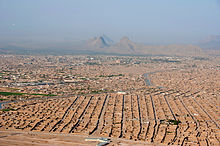| Fall of Kandahar | |||||||
|---|---|---|---|---|---|---|---|
| Part of the Afghan Civil War and the War in Afghanistan (2001–2021) | |||||||
 Aerial view of a section of Kandahar | |||||||
| |||||||
| Belligerents | |||||||
|
|
| ||||||
| Commanders and leaders | |||||||
|
|
| ||||||
| Strength | |||||||
|
3,000 Karzai militia[3] 350 Sharzai's militia[4] 800 Eastern Alliance 750 Americans 150 Australians |
Unknown number of Taliban fighters 300 Al-Qaeda fighters[4] | ||||||
| Casualties and losses | |||||||
|
Unknown Afghan losses 3 Americans killed | Unknown | ||||||
The Fall of Kandahar took place in 2001 during the War in Afghanistan. After the fall of Mazar-i-Sharif, Kabul and Herat, Kandahar was the last major city under Taliban control. Kandahar was where the Taliban movement had originated and where its power base was located, so it was assumed that capturing Kandahar would be difficult. The city fell after several weeks of fighting to a force of local militia under Pashtun military commanders and their American advisers. The fall of Kandahar signaled the end of organized Taliban control of Afghanistan.[5]
- ^ a b Dam, Bette (2019). "The Secret Life of Mullah Omar" (PDF). Zomia Center. Archived from the original (PDF) on 6 October 2022. Retrieved 29 June 2022.
- ^ Said 2018, p. 80.
- ^ Malkasian, Carter (2021). The American War in Afghanistan: A History. Oxford University Press. ISBN 978-0-19-755077-9.
- ^ a b Malkasian 2021.
- ^ On The Ground – The Fall Of Kandahar | Campaign Against Terror | FRONTLINE | PBS